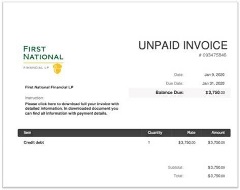In all fraud schemes, be aware of misspellings and bad grammar, requests for immediate attention and secrecy, and promises of a monetary payout or elaborate prizes in exchange for a fee. Fraudsters will prey on individuals who respond to these scams. If it sounds too good to be true, then it likely is.
If you believe you are a victim of identity theft or fraud, contact the Canadian Anti-Fraud Centre’s toll-free line at 1.888.495.8501 or online at www.antifraudcentre-centreantifraude.ca for more information.
Thousands of Canadians fall victim to fraud each year. Awareness is the first step to combating fraud and protecting yourself.
Common fraud schemes
Phishing
Phishing involves the act of attempting to acquire information about an individual by masking as a legitimate business through an email message. The email is disguised to convince the receiver that the email is a legitimate request from an existing and
often reputable business or financial institution. The ultimate purpose is to obtain private information that will be used for identity theft. The email will direct the user to visit a website and asks the user to update personal information, usually
passwords, credit card and bank account numbers, social insurance number, etc. The website will often look like an authentic company’s website, but it is a phony site set up with the intent to steal information.
First National will not send unsolicited emails to customers or to the general public asking for personal information.
Inheritance Fraud
Inheritance fraud typically starts with a letter or e-mail falsely informing someone that they are the recipient of a large inheritance. The recipient of the letter or e-mail usually shares the family surname with the “deceased individual”
who has left behind a substantial amount of money deposited at a financial institution, and this money will be turned over to the government if a family member sharing the surname of the deceased is not located. The letter or email assures the
recipient that the funds will be released to them legally, requests that the recipient act quickly and states the need to keep the letter private and confidential. Once the recipient responds to the letter, the fraudsters will ask for fees to be paid
in preparation for the release of non-existent funds.
To add credibility, fraudsters will falsely claim that they represent or work for a legitimate company. Companies that track down heirs do legitimately exist; however, they do not contact recipients of an inheritance in this way.
First National would not be contacting its customers or members of the public in this manner.
Lottery Scams
Lottery scams usually originate from an email or a phone call from someone claiming to be with a lottery corporation or another organization, stating that your name or email address has been selected and that a prize has been won. In order to claim the
prize, the victim is asked to send money to cover the service fees or taxes related to the prize. Legitimate lottery prizes are tax-exempt in Canada. Fees or taxes do not have to be paid to Canadian authorities on legitimate lottery winnings. If you
have not entered a contest or purchased a lottery ticket, be vigilant; it is likely a scam.
Invoice Fraud

Fraudsters are spoofing company logos and other organizational details to create fake invoices for circulation to trick recipients into paying for products or services that they did not request. Many of these “invoices” may appear to
be legitimate invoices and may include links to download invoice details or include threatening and confusing language to create a false sense of urgency to make payments as quickly as possible. The services listed in fake invoices vary but
commonly include these words or phrases: credit debit, mortgage services, legal services, compliance services, etc. Be skeptical of invoices that do not have a telephone number, contact name or address to contact the Company.
If
an email and invoice appear suspicious, here are some steps you can take:
- Do not click on any links in the email – these scams can contain malicious links or attachments (e.g. phishing)
- Google any companies, individuals, addresses and phone numbers in the message. Look for more than an official company website or logo; flashy fonts can be easily created
- Do not use “reply” to answer a suspicious email from an unknown entity